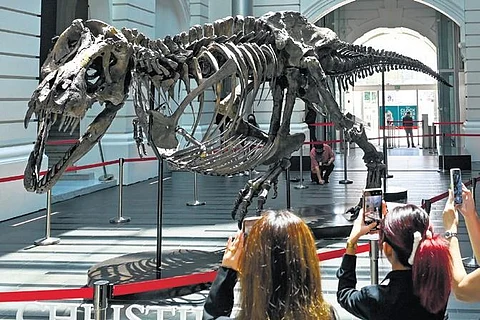

Palaeontologists are mortified at the news of Europe’s first auction of a Tyrannosaurus rex skeleton. To go under the hammer next Tuesday at the Koller auction house in Zurich, Switzerland, ‘Trinity’ is a sort of intra-species chimaera, made up of the fossil bones of three dinosaurs discovered in the Hell Creek and Lance Creek formations in Montana and Wyoming. There is disquiet among scientists because the expected price of $5.5–8.8 million puts most museums and research bodies out of the game—and the trade buzz is that the estimate is low. If Trinity goes to a private collector, it will become inaccessible to scientific work and teaching—even to school kids, who are the most dedicated dino fiends.
Palaeontologists have always been uneasy about the private fossil trade, because buyers are both institutions like universities and museums, which acquire knowledge in order to give public access to it, and collectors who buy an artefact with the specific intention of keeping it to themselves. Antiquities, like finds from the Egyptian pyramids—both authentic and fake—have been privately traded from colonial times, and the fossil trade went pro in 1993. The release of Jurassic Park (the movie, not the book) drove public interest to fever pitch and a Bonhams auction of a nest of 10 sauropod eggs from China became a telephonic war between two anonymous collectors. Final sale value: $143,000, including the consideration for 23 dinosaur coprolites (fossilised dung) which had been polished to a sparkling finish using agate. The things that people are willing to collect! In 2021, a 66 million-year-old Triceratops skeleton went on sale for $7.7 million and last year, a Gorgosaurus was also on the block. In 2020, in the thick of the pandemic, Christie’s sold a T. rex fossil nicknamed ‘Stan’ for $31.8 million in the most expensive fossil auction ever.
The private sale of T. rex fossils always heightens feelings because it’s the most widely recognised species, though it must have been among the least populous. Copies of ‘Stan’ are installed in most museum dino sections, and the 2020 sale did not include replication rights. However, only 32 skeletons of the world’s most intimidating land predator have ever been found. Every fossil that falls into private hands is a loss to everyone who has an interest in the past.
Besides, a paper by the neuroscientist Suzana Herculano-Houzel in the Journal of Comparative Neurology in January suggests that T. rex and Allosaurus had about the same number of neurons in the brain as baboons and monkeys, and therefore could have had ‘flexible cognition’, solved fairly complex problems, used tools, lived long and transmitted their culture across generations, like many modern primates and birds do. By culture, the author means a “body of knowledge and technology that gets passed down across generations and built upon,” as she explained on Twitter. The finding suggests that T. rex was a far more efficient hunting machine than was previously thought.
It is interesting to see that two of three widely read classics of dinosaur sci-fi are about hunting, perhaps because they were written when hunting was an essential part of the American way and Field & Stream was a bestselling magazine. The last, Jurassic Park, was written in 1990, when the excesses of the previous generation had taken their toll on the wild and conservation was suddenly fashionable. Our interest here is in the earlier hunting classics, like L. Sprague de Camp’s 1956 novelette A Gun for Dinosaur, which is anchored by the time-travelling hunting guides Reginald Rivers and Chandra Aiyar (The Raja of Janpur who, presumably bankrupted by the abolition of privy purses, has become a travel agent in New York City). They take hunters back to the Cretaceous, in search of the head of a T. rex to mount on the living room wall. A T. rex is indeed found, but the story is not about dinosaurs, though it features in dinosaur fiction collections. It’s a classic about the dangers of time travel—like exiting your time machine at a point which, in the past or future, was or will be under the surface of the earth—and its paradoxes, like travelling back in time to kill your grandmother, and thus preventing your own birth.
More to the point is Isaac Asimov’s 1950 short story Day of the Hunters, which was re-collected in his 1975 anthology Buy Jupiter and Other Stories. It’s a story told by a university teacher who travelled back to the Mesozoic to see why dinosaurs became extinct—and was hunted by them. He discovered a culture of hunting among the smaller dinosaurs, who were intelligent and bore firearms. And after they were done shooting all the bigger dinosaurs in a gigantic mass extinction, there was nothing left to shoot, except each other.
This is, of course, a reptilian parable for the age of mammals. Sapiens, a small but heavily armed mammal, has taken the planet for its own, reducing the range of the larger mammals to game reserves. There’s no one left to hunt but each other. The culture of hunting is so deeply embedded in the human psyche that we just can’t stop.
Of course, that’s not how it happened. The Cretaceous-Paleogene extinction 66 million years ago is attributed to a meteorite strike in Central America. The age of the dinosaurs ended and mammals rose in their place. Now, the only mammal smart enough to toy with hubris is interfering with the planet energetically enough to trigger the next mass extinction. As a sense of foreboding develops about climate change, the dinosaurs, our forerunners in the race to extinction, look more fascinating than ever before. And it seems a shame to buy and sell their remains.
Pratik Kanjilal
Editor of The India Cable
(Tweets @pratik_k)